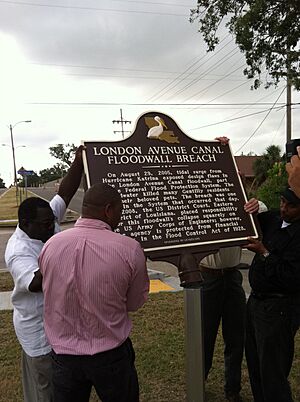London Avenue Canal facts for kids
The London Avenue Canal is a special waterway in New Orleans, Louisiana. It helps pump rainwater away from the city and into Lake Pontchartrain. This canal runs through the 7th Ward of New Orleans, from the Gentilly area all the way to the lake. It's one of three main canals that drain rainwater from New Orleans. In 2005, during Hurricane Katrina, the flood walls of the London Avenue Canal broke on both sides.
Contents
History of the London Avenue Canal
Building the Canal for Trade and Drainage
The London Avenue Canal was built a long time ago, in the early 1800s. A man named Alexander Milne asked for it to be built. He owned a lot of land that was mostly swamp back then.
At first, the canal was used for small boats to travel from Lake Pontchartrain into New Orleans. It also helped drain some of the swampy land. By the late 1800s, most boats used other canals. So, the London Avenue Canal became mainly for draining rainwater from the city streets.
Modernizing Drainage and City Growth
In the early 1900s, the old steam-powered pump at the canal was replaced. A new, more powerful system was designed by A. Baldwin Wood. This improved drainage allowed more homes to be built in the Gentilly neighborhood near the canal. Dillard University was also built next to the canal.
In the 1930s, new levees were built along Lake Pontchartrain. The Paris Avenue Canal was also constructed. These projects helped drain even more land along the London Avenue Canal. By 1945, with more pumps added, the entire area along the canal was developed into neighborhoods. A big project to upgrade the floodwalls and bridges began in 1999.
London Avenue Canal Breaches During Hurricane Katrina
When the Floodwalls Broke
In August 2005, Hurricane Katrina hit New Orleans. The London Avenue Canal's floodwalls broke on both sides. This happened even though the water levels were much lower than the walls were designed to handle.
The east side of the canal broke first, around 6 or 7 in the morning. It sent tons of sand and water into the Mirabeau neighborhood. The west side broke an hour later, flooding the Lake Vista neighborhood.
Repairing the Damage
The U.S. Army Corps of Engineers worked hard to fix the breaks in September. More flooding happened during Hurricane Rita the next month. However, it didn't cause new damage beyond what Katrina had already done. Water kept leaking from the temporary repairs until January 2006. That month, the Army Corps of Engineers finished temporary fixes for the canal breaches.
Investigations into the Canal Breaches
Why Did the Walls Fail?
After Hurricane Katrina, the Army Corps of Engineers started an investigation. It was called the Interagency Performance Evaluation Task Force (IPET). They found that the canal floodwalls broke at much lower water levels than they should have. This was because of a problem with their design.
In 2007, the Corps announced more findings. They said that some of the remaining floodwalls could only safely hold 7 feet (2.1 m) of water. This was half of their original design to hold 14 feet (4.3 m).
Faulty Design and Its Impact
An article in 2015 confirmed that both breaches were due to a faulty design. The authors said the Army Corps of Engineers had misunderstood a test they did in the 1980s. Engineers thought they could install sheet pilings (long, flat pieces of metal driven into the ground) at a depth of only 17 feet. They should have been driven 31 to 46 feet deep. Using shorter pilings saved money but made the walls less reliable.
In 2008, a judge said the U.S. Army Corps of Engineers was responsible for the design flaws. However, the agency could not be made to pay for damages. This was due to a law called the Flood Control Act of 1928.
Making the Canal Safer Today
After Hurricane Katrina, the Army Corps has made the London Avenue Canal much stronger. Here's how:
- They installed large gates with powerful pump stations at the canal's entrance to Lake Pontchartrain.
- They set a "safe water" level for the canals. This level is lower than the height of the canal walls.
- Steel sheet pilings were driven much deeper into the ground.
- They added "relief walls" that act like warning gauges.



